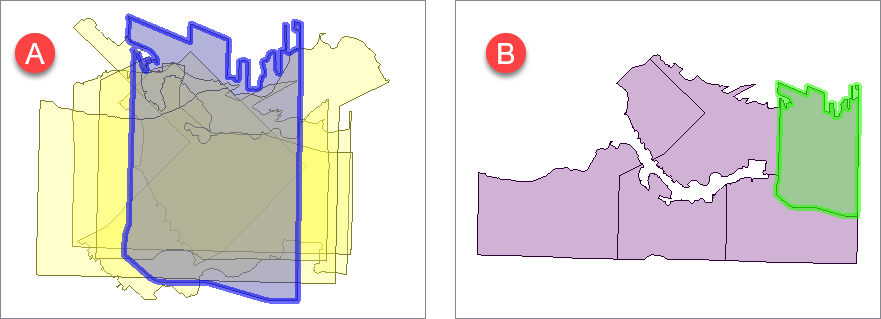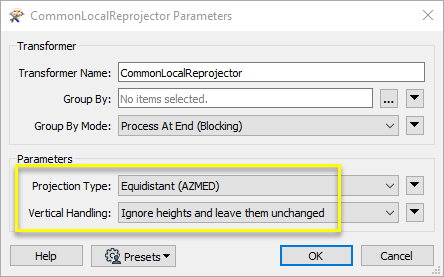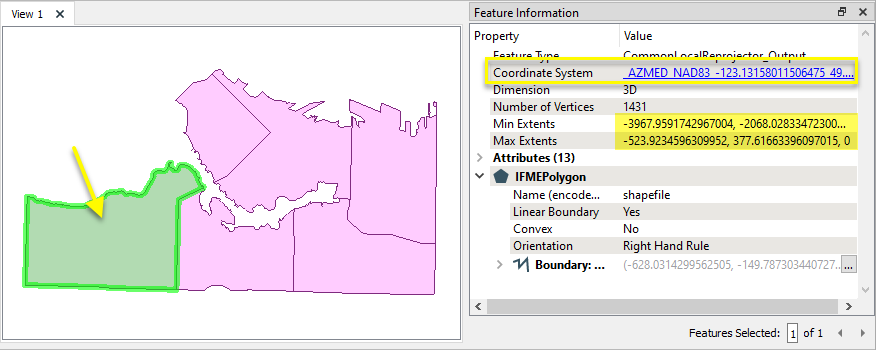Reprojects one or more features to a local coordinate system centered on the bounding box containing all features.
Typical Uses
- Reprojecting multiple features into the same local coordinate system
How does it work?
The CommonLocalReprojector receives features and calculates their cumulative bounding box, then reprojects the features to a local coordinate system centered on that box with ground units in meters.
The Projection Type may be either Equidistant (AZMED) or Equal Area (ASMEA).
Reprojector vs. CommonLocalReprojector
The Reprojector can also reproject features to local coordinate systems, however, each feature is handled individually and receives its own coordinate system based on its bounding box. An example using neighborhood polygons is shown below (A). Each feature’s origin is at its center, and so they appear stacked on top of each other.
The CommonLocalReprojector creates a single local coordinate system that spans all of the input features, and applies it to all of them (B).

Z Values
Height is not considered so areas or distances are best preserved for geometry at an ellipsoid height of 0 meters. Despite height not affecting the coordinate system that will be generated, Z values may undergo a unit shift or geocentric to ellipsoid height conversion if a Vertical Handling mode of Heights are relative to the ellipsoid or geocentric is chosen.
Examples
In this example, we have a set of neighborhood polygons, in a UTM coordinate system. Note that the extents are appropriate coordinates.
We want to reproject these polygons to a single common local coordinate system.

The features are routed into a CommonLocalReprojector.

In the parameters dialog, we set Projection Type to Equidistant (AZMED), and leave Vertical Handling as its default, Ignore heights and leave them unchanged.

The features are output to a local coordinate system based on the bounding box of all input features.

Usage Notes
- Rasters may only be reprojected in 2D (that is, with Vertical Handling set to Ignore heights and leave them unchanged).
Working With Coordinate System Transformers
FME inherently supports coordinate system transformations and reprojections, using the CS-Map coordinate system library.
Coordinate systems generally have a name and a definition, and the syntax of that definition can vary greatly between both spatial data formats and other coordinate system libraries. Custom and local coordinate systems can also be defined in FME, further complicating matters. For in-depth information, see the Working With Coordinate Systems documentation.
Coordinate System Support
These transformers perform various coordinate system-related tasks, but do not reproject the data. If a coordinate system library is required for a task, CS-Map is used.
|
Converts coordinate system names and definitions between FME’s internal format and common third-party and open source representations, storing the results as an attribute. |
|
|
Retrieves the FME coordinate system name of the feature into an attribute. |
|
|
Removes the coordinate system from features, without modifying geometry or coordinates. |
|
|
Assigns a specified coordinate system to features, without modifying geometry or coordinates. |
|
|
Assigns a specified local coordinate system to features, without modifying geometry or coordinates. |
Coordinate System Reprojection
Different coordinate system libraries (engines) not only contain coordinate system definitions, they also have unique reprojection algorithms. FME’s generic reprojection transformers, in the first table below, use CS-Map. A selection of other libraries is also available, some of which are specific to certain areas of the world or certain software platforms.
Default reprojections, as in a workspace with different input and output coordinate systems selected, are performed with the CS-Map library, also the equivalent of using the generic Reprojector transformer.
If you are reprojecting explicitly with a transformer in the workspace, using library-specific transformers is recommended. In the case of CsmapReprojector versus the Reprojector, the library is identical, but the CSMapReprojector handles vertical coordinate calculations whereas the Reprojector does not.
Generic Reprojection Transformers
|
|
|
Library |
|---|---|---|
|
Reprojects x and y coordinates stored as attributes from one coordinate system to another. |
CS-Map |
|
|
Reprojects one or more features to a local coordinate system centered on the bounding box containing all features. |
CS-Map |
|
|
Converts a given angle from one coordinate system to another. |
CS-Map |
|
|
Converts a given distance from one coordinate system to another. |
CS-Map |
|
|
Reprojects feature x and y coordinates from one coordinate system to another. |
CS-Map |
Library-Specific Reprojection Transformers (Recommended)
|
|
|
Library (External Links) |
|---|---|---|
|
Reprojects x, y, and optionally z coordinates stored as attributes from one coordinate system to another using the CS-MAP library. |
||
|
Reprojects feature x, y, and optionally z coordinates from one coordinate system to another using the CS-Map library. |
||
|
Reprojects feature coordinates from one coordinate system to another using the Esri reprojection library. |
||
|
Great Britain Northern Ireland Republic of Ireland |
Reprojects feature coordinates from one coordinate system to another using the Grid InQuestII reprojection library. This library allows you to use the GridInQuestIIReprojector to transform coordinates between ETRS89 (WGS84) and the national coordinate systems of Great Britain, Northern Ireland and the Republic of Ireland. |
|
|
Sweden |
Reprojects attributes holding coordinate values from one coordinate system to another using the Gtrans reprojection library (from the National Land Survey of Sweden), and the specified translation file. |
|
|
Sweden |
Reprojects features from one coordinate system to another using the Gtrans reprojection library (from the National Land Survey of Sweden) and the specified translation file. |
|
|
Reprojects attributes from one coordinate system to another using the PROJ library. |
||
|
Reprojects feature coordinates from one coordinate system to another using the PROJ library. |
||
|
Switzerland |
Reprojects feature coordinates from one coordinate system to another using the REFRAME library. This transformer handles the usual planimetric and altimetric reference frame change for Switzerland. |
Configuration
Input Ports
This transformer accepts any feature.
Output Ports
Features reprojected to a new local coordinate system as specified in parameters.
Parameters
|
Group By |
If blank, all features will be reprojected to the same local coordinate system. If attributes are specified, each group of features will be reprojected to a local coordinate system centered on that group. |
|
Group By Mode |
Process At End (Blocking): This is the default behavior. Processing will only occur in this transformer once all input is present. Process When Group Changes (Advanced): This transformer will process input groups in order. Changes of the value of the Group By parameter on the input stream will trigger processing on the currently accumulating group. This may improve overall speed (particularly with multiple, equally-sized groups), but could cause undesired behavior if input groups are not truly ordered. There are two typical reasons for using Process When Group Changes (Advanced) . The first is incoming data that is intended to be processed in groups (and is already so ordered). In this case, the structure dictates Group By usage - not performance considerations. The second possible reason is potential performance gains. Performance gains are most likely when the data is already sorted (or read using a SQL ORDER BY statement) since less work is required of FME. If the data needs ordering, it can be sorted in the workspace (though the added processing overhead may negate any gains). Sorting becomes more difficult according to the number of data streams. Multiple streams of data could be almost impossible to sort into the correct order, since all features matching a Group By value need to arrive before any features (of any feature type or dataset) belonging to the next group. In this case, using Group By with Process At End (Blocking) may be the equivalent and simpler approach. Note: Multiple feature types and features from multiple datasets will not generally naturally occur in the correct order. As with many scenarios, testing different approaches in your workspace with your data is the only definitive way to identify performance gains. |
|
Projection Type |
Select a Projection Type based on whether preservation of distances or areas is more important. Choices include:
|
|
Vertical Handling |
Select a method for Z value handling:
|
Editing Transformer Parameters
Using a set of menu options, transformer parameters can be assigned by referencing other elements in the workspace. More advanced functions, such as an advanced editor and an arithmetic editor, are also available in some transformers. To access a menu of these options, click  beside the applicable parameter. For more information, see Transformer Parameter Menu Options.
beside the applicable parameter. For more information, see Transformer Parameter Menu Options.
Defining Values
There are several ways to define a value for use in a Transformer. The simplest is to simply type in a value or string, which can include functions of various types such as attribute references, math and string functions, and workspace parameters. There are a number of tools and shortcuts that can assist in constructing values, generally available from the drop-down context menu adjacent to the value field.
Using the Text Editor
The Text Editor provides a convenient way to construct text strings (including regular expressions) from various data sources, such as attributes, parameters, and constants, where the result is used directly inside a parameter.
Using the Arithmetic Editor
The Arithmetic Editor provides a convenient way to construct math expressions from various data sources, such as attributes, parameters, and feature functions, where the result is used directly inside a parameter.
Conditional Values
Set values depending on one or more test conditions that either pass or fail.
Parameter Condition Definition Dialog
Content
Expressions and strings can include a number of functions, characters, parameters, and more.
When setting values - whether entered directly in a parameter or constructed using one of the editors - strings and expressions containing String, Math, Date/Time or FME Feature Functions will have those functions evaluated. Therefore, the names of these functions (in the form @<function_name>) should not be used as literal string values.
| These functions manipulate and format strings. | |
|
Special Characters |
A set of control characters is available in the Text Editor. |
| Math functions are available in both editors. | |
| Date/Time Functions | Date and time functions are available in the Text Editor. |
| These operators are available in the Arithmetic Editor. | |
| These return primarily feature-specific values. | |
| FME and workspace-specific parameters may be used. | |
| Creating and Modifying User Parameters | Create your own editable parameters. |
Dialog Options - Tables
Transformers with table-style parameters have additional tools for populating and manipulating values.
|
Row Reordering
|
Enabled once you have clicked on a row item. Choices include:
|
|
Cut, Copy, and Paste
|
Enabled once you have clicked on a row item. Choices include:
Cut, copy, and paste may be used within a transformer, or between transformers. |
|
Filter
|
Start typing a string, and the matrix will only display rows matching those characters. Searches all columns. This only affects the display of attributes within the transformer - it does not alter which attributes are output. |
|
Import
|
Import populates the table with a set of new attributes read from a dataset. Specific application varies between transformers. |
|
Reset/Refresh
|
Generally resets the table to its initial state, and may provide additional options to remove invalid entries. Behavior varies between transformers. |
Note: Not all tools are available in all transformers.
Reference
|
Processing Behavior |
|
|
Feature Holding |
Yes |
| Dependencies | None |
| FME Licensing Level | FME Base Edition and above |
| Aliases | |
| History |
FME Community
The FME Community is the place for demos, how-tos, articles, FAQs, and more. Get answers to your questions, learn from other users, and suggest, vote, and comment on new features.
Search for all results about the CommonLocalReprojector on the FME Community.
Examples may contain information licensed under the Open Government Licence – Vancouver and/or the Open Government Licence – Canada.




